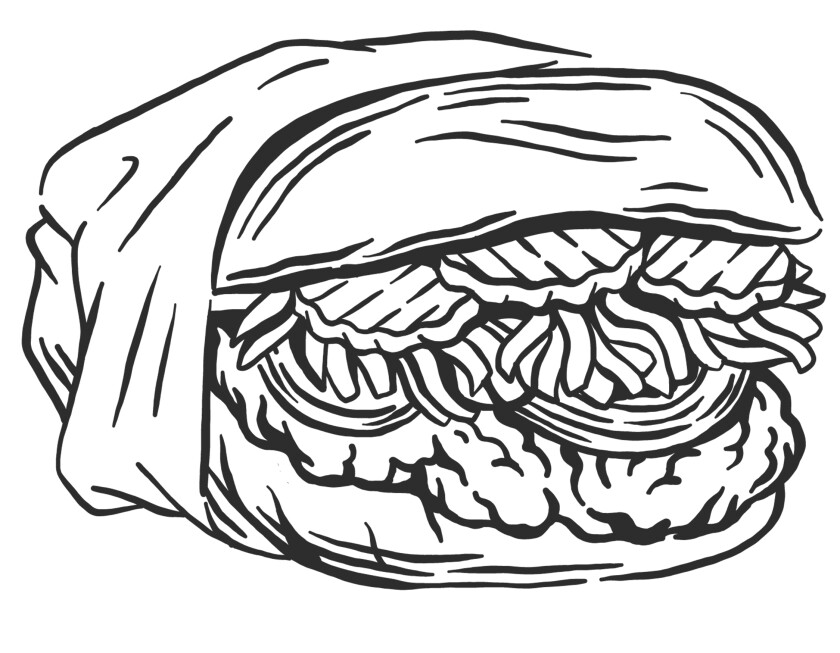L.A. dining culture thrives on plurality. Restaurants in the region’s many rooted immigrant communities cook remarkable foods to please their own populaces. Second-generation chefs graft traditions and innovations in singular ways, often returning to the dishes of their heritage after stints in fine-dining kitchens. Among food lovers, $2.25 fried shrimp tacos from Mariscos Jalisco carry capital equal to Spago’s $28 smoked salmon pizza.
It’s impossible to capture every happening in the last 10 years of L.A. dining. But as part of our look back at the decade, we present some highlights: openings, closings and events with major cultural ripples.
Coming into the decade
(Paula Schultz / For The Times)
- November 2008: Chef Roy Choi launches Kogi, a food truck selling tacos that riff off Korean flavors. Kogi announces its daily locations via Twitter. In the thick of the Great Recession, its food and its social media savvy create a local and national sensation.
- L.A.’s hottest new restaurants at the dawn of the 2010s: the Bazaar, José Andrés’ modernist tapas wonderland in the SLS Beverly Hills; Nancy Silverton’s Osteria Mozza and Pizzeria Mozza; and Jon Shook and Vinny Dotolo’s hyper-rich, Southern-inflected Animal.
- June 2009: After issuing Los Angeles-area guides for 2008 and 2009, Michelin announces it will discontinue covering the city. A press release initially cites the economic situation as the reason; “The people in Los Angeles are not real foodies,” Jean-Luc Naret, then-director of the guides, later said.
2010
- Ludo Lefebvre is in the middle of his run of LudoBites pop-ups, which will last from 2007 to 2012. Formerly a chef at French classics L’Orangerie and Bastide, Lefebvre uses the pop-ups to introduce his evolving, groundbreaking style (layers on the plate, seemingly contrapuntal flavors) while bucking established ideas about restaurant settings.
- The Test Kitchen in Pico-Robertson becomes another ephemeral draw, hosting chefs testing concepts or riffing on fresh ideas for three- or four-day stints. Bill Chait is a partner; he’ll soon make his mark as one of the decade’s formative restaurateurs. His Sprout Restaurant Group (which he leaves in 2015) funds some of the decade’s defining restaurants, among them Bestia, République, Sotto, Broken Spanish, Otium and Vespertine.
- The Kogi team opens its first bricks-and-mortar restaurant, Chego, and labels it an “L.A.-in-a-rice-bowl spot.” In a mention of the dish Hot Buttered Kimchi Chow in his roundup of the year’s best dishes, Jonathan Gold writes presciently in L.A. Weekly: “Is this the year of metacuisine? I believe it must be, with flavors and expectations and ethnic paradigms folded over themselves like picture planes in a David Choe painting: food about food about food.”

(Paula Schultz / For The Times)
- Red Medicine managing partner Noah Ellis snaps a picture of Times restaurant critic S. Irene Virbila, refuses her service and posts her photo on Twitter. Critics losing their anonymity to the internet age was nothing new, but Ellis’ unapologetic tone around his actions makes national news.
2011
- Spice Table opens downtown; the restaurant introduces Bryant Ng’s cooking, honoring the flavors of his Singaporean heritage (with culinary nods to wife and business partner Kim Luu-Ng’s native Vietnam). The restaurant will close in 2013 when its building is marked for demolition, but it paves the way for Ng and Luu-Ng’s Santa Monica 2016 game-changer Cassia.

(Paula Schultz / For The Times)
- Despite mixed reviews, Michael Voltaggio’s buzzy Ink, which serves gimmicky dishes like octopus with cream of dehydrated potatoes and lemon curd, is a hit — and a peak moment for critical recognition of “Top Chef”-helmed restaurants in Los Angeles, which will become a fixture over the next decade.
- Evan Kleiman, chef and host of KCRW’s weekly program “Good Food,” announces she’ll close her influential Melrose Avenue restaurant, Angeli Caffe. Angeli opened in 1984 and helped codify California-Mediterranean cooking.
2012
- Jonathan Gold, who five years earlier became the first restaurant critic to win the Pulitzer Prize for criticism, returns to The Times; he first published restaurant reviews in the paper’s pages in 1990 during Ruth Reichl’s tenure as food editor. Coming back in 2012, he abolishes the star system established by Virbila.

(Paul Schultz / For The Times)
- Ari Taymor’s modernist-Californian restaurant Alma, which began as a series of pop-ups, serves tasting menus in a bare-bones space on a then-forlorn block of downtown. Financial pressures force Taymor and partner Ashleigh Parsons to close in 2015, but Alma’s fierce creativity helps inspire a new generation of tiny, bleeding-edge L.A. restaurants.
- Wolfgang Puck’s flagship Spago in Beverly Hills turns 30. The space receives a sleek, modernist makeover; critics rave about the cooking under the direction of chef Tetsu Yahagi. What’s old is new again.

(Paula Schultz / For The Times)
- Jam maker Jessica Koslow brings Sqirl to life in a threadbare Virgil Village space. Dishes such as her lemony sorrel pesto rice bowl and billowy brioche toast with ricotta and jam will spark an all-day dining revolution, changing how restaurants across the U.S. approach breakfast service.
- Wes Avila left behind cooking at tasting-menu restaurants to launch Guerrilla Tacos as a street stall; soon he would serve his tacos from a truck, using tortillas as canvases for uni, foie gras (then legal) and farmers market fineries. Gold notes in a 2014 review in The Times: “A Ducasse disciple quitting his job at an haute-cuisine pop-up to serve charred octopus tacos on a downtown street corner? You’re not going to find cooking like this anywhere else but L.A.”
- Shunji Nakao, a longtime chef at Matsuhisa and a founder of Asanebo, opens his Sawtelle restaurant Shunji in a funny-shaped building once home to a Chili Bowl. He puts forth an Angeleno style of omakase interspersed with ingenious vegetable dishes.
- Ori Menashe and Genevieve Gergis launch industrial-chic Bestia in the Arts District. The couple isn’t the first to open a triumph in the Arts District — Yassmin Sarmadi and Tony Esnault’s Church & State broke the mold of what could and couldn’t open in the area in 2009 — but the hype around Bestia’s bombastic pastas and pizzas ignites the area for new restaurants.
2013
- Tony Xu opens Chengdu Taste; its aggressively spiced, often incendiary dishes (boiled fish with green pepper sauce, toothpick lamb with cumin, “Diced Rabbit With Younger Sister’s Secret Recipe”) set off a fervor for regional Sichuan cuisine that reverberates across the nation.
- Husband and wife Fernando Lopez and Maria Monterrubio opened Oaxacan restaurant Guelaguetza in 1994. In 2013, Paulina, Fernando Jr., Elizabeth and Bricia Lopez buy the business from their parents, who are set to retire, ensuring that the Koreatown restaurant remains an embassy for Oaxacan culture for another generation.
- Ludo Lefebvre settles into Trois Mec, an exhilarating tasting-menu restaurant hidden behind the scruffy exterior of a former pizzeria. Lefebvre’s partners are Jon Shook and Vinny Dotolo. The two become the decade’s most prominent L.A. restaurateurs, opening their own Jon and Vinny’s restaurants (following Animal and Son of a Gun) and helping other chefs — most notably Lefebvre and Sara Kramer and Sarah Hymanson of Kismet in East Hollywood open theirs.
- Walter and Margarita Manzke take over the Campanile space made legendary by Nancy Silverton and Mark Peel. It’s the end of an era, but the Manzkes steadily build their all-day restaurant/cafe/bakery, République, into a triumph in its own right.
- Carlos Salgado opens Taco Maria in Costa Mesa. He attracts national attention serving intricate yet earthy four-course dinners and sublime daytime tacos on tortillas made from corn varieties grown by independent farms in Mexico.
2014
- Night + Market Song in Silver Lake blasts onto the scene. Kris Yenbamroong first made his presence known in 2011 with the original Night + Market attached to Talesai, his parents’ Thai restaurant on the Sunset Strip. The Thai cooking at Yenbamroong’s second restaurant, with herb-strewn blood soup alongside an off-menu fried chicken sandwich (and lots of natural wine), sparks all the right questions around notions of authenticity and subversion.
- Josef Centeno, a chef as industrious as he is gifted, opens Orsa & Winston, a modern American tasting-menu restaurant with heavy Japanese influences. It joins his Bar Amá (serving the Tex-Mex of his San Antonio upbringing) and Mediterranean-leaning Bäco Mercat, which both opened earlier in the decade in downtown’s Historic Core.
- Sticky Rice (which opened in 2013; its speedy expansion, Sticky Rice 2, came a year later) and Wexler’s Deli headline a new crop of vendors that bring renewed attention to downtown’s essential institution, Grand Central Market.
- Bakery-cafe Gjusta is the follow-up to nearby Gjelina, a Cal-Ital fantasy that became a star vehicle for chef Travis Lett. Mob scenes show up for porchetta melts and colorful salads — and for breakout star Nicole Rucker’s rhubarb-raspberry pie.

(Paula Schultz / For The Times)
- Nancy Silverton wins the James Beard Foundation’s Outstanding Chef award, the organization’s highest honor for a chef. The last time a Los Angeles chef took home the big prize was Wolfgang Puck in 1998 (and even that was a tie with New York’s Jean-Georges Vongerichten).
2015
- n/naka opened in 2011. But after chef-owner Niki Nakayama is the subject of an emotionally rich episode of Netflix’s “Chef’s Table” in April 2015, the 26-seat kaiseki restaurant gains (deserved) world renown; reservations become — and remain — nearly impossible to score.
- At Hollywood’s bare-bones Baroo, Kwang Uh transfixes the food world with his spellbinding cooking, a style that defies definition but incorporates Korean ingredients and techniques, fermentation in myriad guises and comforting pastas and grain bowls. A grueling two-man operation, Baroo will shutter in 2018. (A temporary reincarnation at the Union Swap Meet in East Hollywood closes at the end of 2019.)
- Charles Olalia leaves his post as executive chef of Patina in Walt Disney Concert Hall for Rice Bar, a 275-square-foot counter space where he immerses himself in the foods of his native Philippines. His Filipino heirloom rice bowls and pork longganisa herald a mainstream arrival of Filipino cooking in Southern California, which includes Chinatown’s Lasa, Santa Ana’s now-closed Irenia and Olalia’s follow-up project, Ma’am Sir.
- Cassia merges Westside glitz with Bryant Ng’s soulful Vietnamese-French cooking. The Santa Monica brasserie is also a crown jewel for Josh Loeb and Zoe Nathan’s emergent Rustic Canyon Family; other restaurants in the group include Rustic Canyon, Huckleberry Bakery and Cafe, Milo & Olive and, in 2019, Jeremy Fox’s Birdie G’s.
- After working for Jaime Martin del Campo and Ramiro Arvizu at their La Casita Mexicana in Bell, and partnering on La Diosa de los Moles in Sun Valley, Oaxaca native Rocio Camacho opens her first solo venture, Rocio’s Mexican Kitchen, in Bell Gardens. The restaurant showcases her astonishing moles.
2016
- Roy Choi and Daniel Patterson open Locol in Watts, a fast-food chain aimed at feeding underserved areas. A second location opened the same year in Oakland. Its zero-star review from New York Times critic Pete Wells receives backlash; Jonathan Gold would go on to crown Locol restaurant of the year. The restaurant falters and closes by 2018. Locol’s kitchen manager, Keith Corbin, will become the chef at Alta Adams later in 2018, with backing by Patterson.

(Paula Schultz / For The Times)
- Howlin’ Ray’s debuts in Chinatown’s Far East Plaza. In 2014 Johnny Ray Zone toured Nashville’s long-established hot chicken scene, popularized by Prince’s Hot Chicken’s radically spicy bird. He began serving hot chicken sandwiches from a food truck in 2015. Social media-inflamed demand swiftly calls for a permanent space. Zone’s sandwiches remain the marquee dish fueling L.A.’s hot chicken craze, served by over two dozen restaurants, trucks and pop-ups across the region. (In 2019, Kim Prince of the Prince’s Hot Chicken family opens her own L.A. restaurant, Hotville Chicken & Chops, in Baldwin Hills.)
- The Howlin’ Ray’s phenom also highlights the resurgence of Chinatown’s Far East Plaza as a hub for modern dining, including Alvin Cailan’s Filipino standout Lasa and a location of Roy Choi’s Chego.
- Suzanne Goin wins the James Beard Foundation’s Outstanding Chef award, acknowledging her cooking at Lucques and A.O.C. (among other restaurants). She is the fifth woman to win the title since the awards began in 1990. In 2018 business partner Caroline Styne will win the Outstanding Restaurateur award.
- Smorgasburg L.A., an offshoot of the Brooklyn-based outdoor market, begins setting up weekly gatherings at the new Row DTLA development. It proves to be a showcase both for emerging talent and established chefs; vendors including Banh Oui, Porridge + Puffs and Tacos 1986 go on to open restaurants.
2017
- Jordan Kahn’s Vespertine comes into being in an undulating red Culver City building designed by architect Eric Owen Moss. Vespertine is almost as much an art installation as it is a restaurant; the soundtrack plays four tones repeatedly, and many of the tasting-menu dishes and the dishes they’re served on resemble abstract sculpture. Kahn’s efforts to disrupt entrenched notions of fine dining provoke strong opinions — including Jonathan Gold’s decision to make it No. 1 on his annual best restaurants list.
- Dave Beran — formerly executive chef at Chicago’s shape-shifting restaurant Next — opens Dialogue, an 18-seat tasting-menu restaurant hidden on the second floor of a food court on Santa Monica’s Third Street Promenade. His cerebral tasting menus earn him a fervent following; critics herald the restaurant as a breakthrough in modernist Southern California dining.
- Teddy Vasquez begins selling his birria de res outside a Long Beach bar. His Instagram following for Teddy’s Red Tacos will soar to more than 100,000 in two years. Vasquez is at the center of L.A.’s late-in-the-decade hunger for birria.
- Chef April Bloomfield and business partner Ken Friedman opened the Hearth & Hound in December; shortly afterward, sexual harassment allegations against Friedman emerged in a New York Times article. “Whichever side of the question you lean toward, it is hard not to feel queasy at the result,” Jonathan Gold wrote in his review. Bloomfield eventually takes ownership of the Hearth & Hound. The restaurant will close in January 2019.
- Now Serving L.A. opens. The city’s sole shop dedicated to cookbooks creates a space for community, frequently hosting events with visiting chefs and authors. Ken Concepcion was previously chef de cuisine at Cut in Beverly Hills; he and his wife, Michelle Mungcal, created the store by asking themselves (as they told Amy Scattergood), “Where would cooks and chefs want to hang out on their day off?”
- It’s a banner year for Italian comfort food: Evan Funke’s Felix in Venice and Steve Samson’s Rossoblu in DTLA offer two different but wholly compelling deep dives on pasta; Daniele Uditi, who grew up in a family bakery near Naples, opens Pizzana, where he makes dazzlingly modernized Neapolitan pies.
2018
- Ori Menashe and Genevieve Gergis follow their success with Bestia with Bavel, creating a menu with influences that reflect the couple’s merged heritages: Israeli, Turkish, Egyptian and Moroccan. The restaurant tops local and national “best new” lists for the year, punctuating America’s growing fascination with the flavors of the Middle East.
- David Chang opens Majordomo in Chinatown. It culls ideas presented elsewhere in his Momofuku restaurants but also embraces the Southern California culinary ethos. Angelenos are often wary of outsider chefs with big names, but Majordomo’s approach proves to be a score.
- After nine years, Diep Tran closes Good Girl Dinette in Highland Park. It opened in 2009 and was beloved in the community. Tran cites thin margins and rising costs as reasons for closing. It’s a challenge that chefs and restaurant owners will grapple with by decade’s end.

(Paula Schultz / For The Times)
- Jonathan Gold dies of pancreatic cancer at St. Vincent Medical Center on July 21. He is 57. A week later, on what would have been his 58th birthday, L.A. pays homage to the critic by illuminating landmarks (Los Angeles City Hall, the Broad and and Pacific Wheel on the Santa Monica Pier, among others) in gold lights.
2019
- The Michelin inspectors return to Los Angeles after nearly a decade, via a new guide that covers all of California. The L.A. metro area receives no three-star designations. There are plenty of head-scratching decisions made by the nameless auditors with cryptic rating systems. (For starters: Not even a single star for République?)

(Paula Schultz / For The Times)
- Mei Lin caps the Arts District’s importance as a decade-long drinking and eating destination with her restaurant Nightshade. Her restaurant is at the forefront of changing attitudes around the perception, direction and value of Chinese cooking in Southern California. Jon Yao is another leader, with his Taiwanese-influenced tasting menus at Kato in West L.A., which he opened in 2016; it is No. 1 on The Times’ 2019 101 Best Restaurants in L.A. list.
- After just 11 months, the Manufactory, a massive 40,000-square-foot project at Row DTLA, closes its restaurant operations. The venture, a partnership between Chad Robertson and Elisabeth Prueitt of San Francisco-based Tartine Bakery and Chris Bianco of Pizzeria Bianco, was one of the most anticipated openings in recent years.
- The Original Cannabis Cafe — initially named the Lowell Cafe — is the first restaurant where customers can legally smoke marijuana and eat prepackaged edibles. Chef Andrea Drummer serves a menu of comfort foods; though the kitchen can’t serve dishes prepared with marijuana, she does offer food and weed pairing suggestions.
- Photographer Shawn Nee began Burgers Never Say Die as a backyard pop-up in 2017, serving double cheese smashburgers with crisp, lacy edges. In February he opens a permanent location in Silver Lake; BNSD is at the center of L.A.’s smashburger mania.
